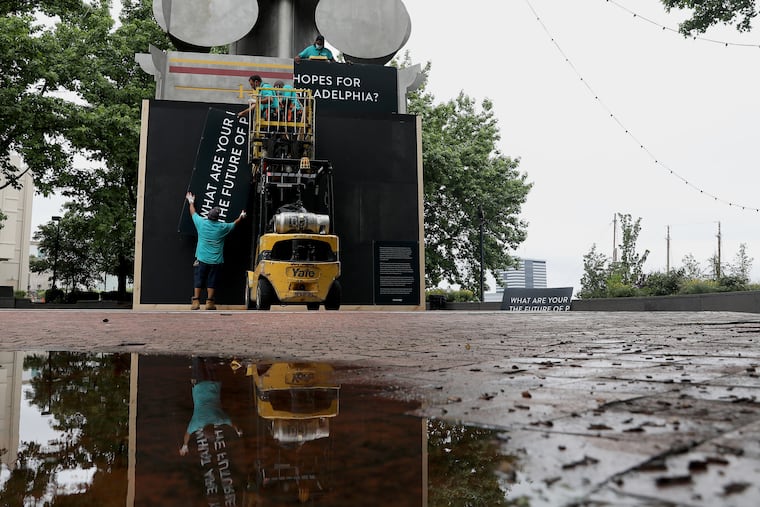Tearing down statues offers only symbolic, not concrete, change | Opinion
Regardless of one’s opinion on Columbus, local leaders should ask themselves: What will be accomplished by removal?

Imagine watching the statue of one of your cultural icons being torn down. Now imagine the statue of someone who committed genocide coming down. This could be the same statue, viewed by two different people with different backgrounds.
That’s what’s happening in Philadelphia — and across the country — right now. It has been almost two months since George Floyd’s death at the hands of police, and Philadelphia, like many other metro areas, has been protesting for almost as long. Many cities are seeing the benefits of their work, with reforms enacted to protect civilians and hold police accountable, and funds are being allocated for mental health care and to benefit underserved communities. For some places, change includes the removal of memorials honoring controversial figures.
» READ MORE: Rizzo, Columbus statue defenders are back in court, challenging city handling of memorials
Emotions are running high, and some members of the Italian American community are reeling over the removal of Christopher Columbus statues. Critics of Columbus rightly note that the legacy of the “explorer” includes the massacre and enslavement of Native peoples.
But ultimately, removal of his statues oversimplifies history and instead prioritizes symbolic changes when we need concrete ones.
Columbus is seen as an icon for many, one that Italians attached themselves to in the late 1800s, when xenophobia was rampant and Italians were ostracized and sometimes killed, like during an 1891 mass lynching of 11 Italians in New Orleans. Some Italian Americans elevated Columbus to seem more than a man — a legend that touted Italian contributions to the U.S., with hopes of gaining respect for Italian people. A year after the New Orleans lynching, to mark 400 years since Columbus’ ship encountered America, President Benjamin Harrison officially declared Columbus Day a national holiday.
Harrison’s intentions were understandable, but at the same time, researcher Kathryn Anastasi asserts that propping up Columbus inadvertently helps Italian Americans take part in the U.S. custom of “violent denial of the existences of indigenous peoples and promote the erasure of [real] Italian American history,” in exchange for “a distinct Italian American history that the mainstream finds acceptable.”
» READ MORE: Living on an Indian reservation changed my mind about Christopher Columbus | Perspective
Anastasi supports what many know: Columbus’ reputation is not in fact great. Columbus wasn’t the first explorer in the Americas, which he happened to bump into trying to find the East Indies. He is heralded, despite the fact that, after he touched down in the Caribbean, the Taíno population dwindled from 250,000 to a few hundred. That is because he rounded up thousands against their will to be enslaved back in Spain.
Still, regardless of one’s opinion on Columbus, local leaders should ask themselves: What will be accomplished by removal? Will marginalized communities suddenly trust officials? Statues are symbolic, just like removing them. We can’t stop at symbolic change. We need an action plan that begins to heal the wounds of minority communities, not proverbial bandages.
That plan should include policies and procedures that provide equity for marginalized communities. Let’s start by banning chokeholds across Pennsylvania, and prioritizing de-escalation from police. Nationally, we should enforce penalties for racially motivated 911 calls (like Amy Cooper’s in New York). Law enforcement in Philly and beyond need to hold themselves accountable, like Louisville, Ky., police need to arrest Breonna Taylor’s killers.
Beyond law enforcement, every profession that is directly responsible for the lives of others — not just police, but in hospitals, courts, and schools as well — should require implicit bias and diversity training. And governments must recognize the importance of, then fund, arts and after-school programs for underserved communities.
» READ MORE: 3 black Philadelphians whose statues should replace Frank Rizzo | Opinion
As for the statues already being taken down: Let’s replace them with admirable figures. For the Italian American community: How about a saint like Mother Cabrini? She was an Italian American nun and the patron saint of immigrants, so how could she not be a unifying figure? What about Leonardo da Vinci? St. Francis of Assisi?
It’s time for Philadelphia, and other cities, to implement changes that don’t just topple historic eyesores but will alter the course of history toward equality and equity.
Tonya Russell is a freelance journalist based in South Jersey.